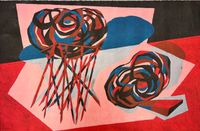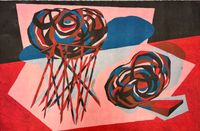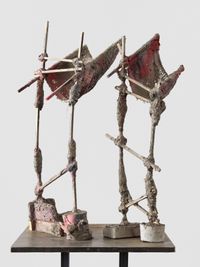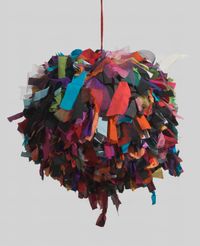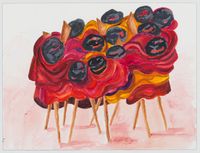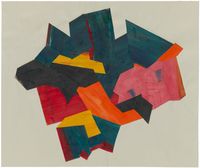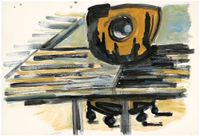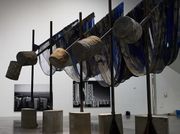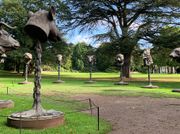British artist Phyllida Barlow was recognised for her large-scale 'nonmonumental' sculptures, made from cheap and household materials, that explore the relationship between objects and their surroundings.
Read MoreBarlow engaged with inexpensive and often lightweight materials in processes of 'expedient' transformation that include breaking, cutting, folding, wrapping, painting, covering, and coiling. Despite the enormous scale of her works, Barlow described them as 'nonmonumental', challenging the grandiosity of the monument with the deliberately messy, crude use of her materials.
Representing Britain at the 57th Venice Biennale (2017), Barlow installed sculptures with rough textures and industrial colours in the national pavilion's rooms. Titled folly, the presentation included columns with openings on one side that revealed the humble origins of their materials despite their appearance. In an interview with British Council Arts, the artist described the latter as a way of coming out of the building, '[spilling] its guts in some way'.
During the 2020 lockdown in London, Phyllida Barlow turned to smaller scale works that were exhibited in small worlds, her first solo show with Hauser & Wirth Zurich in 2021. The new works, presented on similar small plinths or on the wall, impart a sense of intimacy by demanding the viewer to come closer.
Though active since the 1960s, Phyllida Barlow was previously better known as a teacher than an artist. She taught at the Slade School of Art, her alma mater, for more than 40 years until retiring in 2009. Aged 63, Barlow began to gain prominence when she won the Paul Hamlyn award. By 2010, she had held solo and group exhibitions at Studio Voltaire and Serpentine Gallery, London, and began to be represented by Hauser & Wirth.
Barlow's late ascension in the art world has been attributed to sexism as well as socioeconomic factors. In 2017, The Guardian wrote—drawing from conversations with the artist, artistic directors and curators—that her earlier sculptures were not collected in part due to her gender and also the comparative lack of well-established commercial galleries in postwar London. Because of their size and lack of space, many of her works were discarded after being exhibited. With the recent trend in the art world to excavate overlooked women artists, Barlow has begun to receive increased recognition.
Barlow has been internationally recognised for her contributions to contemporary art, including her election as a Royal Academician (2011) and winning the Aachen Art Prize (2012) and Mari Anton & Elsa von Freytag-Loringhoven Art Prize for Women Artists (2019). She was made a dame in 2021.
Phyllida Barlow exhibited internationally.
Solo exhibitions include HURLY-BURLY, Gagosian, Paris (2023); glimpse, Hauser & Wirth, Los Angeles (2022); __Phyllida Barlow: frontier, Hauser der Kunst, Munich (2021); Artist Rooms: Phyllida Barlow, Turner Contemporary, Margate, U.K. (2017); demo, Kunsthalle Zurich (2016); Phyllida Barlow: set, The Fruitmarket Gallery, Edinburgh (2015); siege, New Museum, New York (2012).
Group exhibitions include Gruppenausstellung, Hauser & Wirth, Somerset (2023); Another Energy: Power to Continue Challenging, Mori Art Museum, Tokyo (2021); Crossroads: Carnegie Museum of Art's Collection, 1945 to Now, Carnegie Museum of Art, Pittsburgh (2018); Spacemakers and roomshakers, Art Gallery of New South Wales, Sydney (2018); Versus Rodin: Bodies Across Space and time, Art Gallery of South Australia, Adelaide (2017).
Sherry Paik | Ocula | 2023
